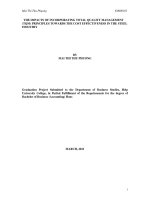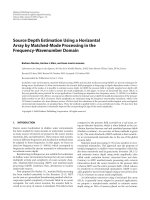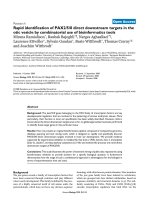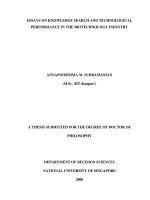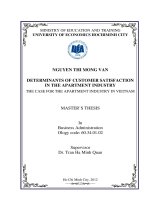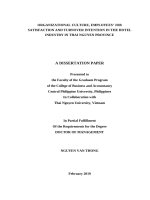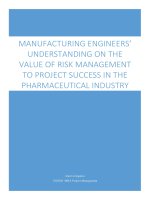Downstream processing in the biotechnology industry / Manohar Kalyanpur
Bạn đang xem bản rút gọn của tài liệu. Xem và tải ngay bản đầy đủ của tài liệu tại đây (113.03 KB, 12 trang )
<span class="text_page_counter">Trang 1</span><div class="page_container" data-page="1">
<small>Molecular Biotechnology 2002 Humana Press Inc. All rights of any nature whatsoever reserved. 1073–6085/2002/22:1/87–98/$13.00</small>
<small>*Author to whom all correspondence and reprint requests should be addressed: Bioseparations and Pharmaceutical Validation, 10 Rue OdilonRedon, 78370 Plaisir, France.</small>
<b>1. Introduction</b>
As the 21st century begins, we look with awe at the accomplishments of new technologies in the last century, especially during the last 20 years. Here, molecular biology has made truly signifi-cant contributions toward the development of new biopharmaceuticals. We have in our hands today the entire human genome and this is indeed a major milestone in biological sciences. This information will provide clues for researchers to develop new drugs that will cure deficiencies and not simply treat their symptoms, as the older phar-maceuticals did. The biotechnology industry will strive harder than ever before to develop new biotherapeutics, and among these new drugs, pro-teins and glycopropro-teins will make up the major part of the targeted drugs. Since the first mono-clonal antibody was licensed for sale in 1986, eight more antibody products have already reached the market, while several more are in dif-ferent stages of development in companies around the world.
The science of biotechnology covers the exploi-tation of microorganisms and mammalian and insect cell cultures, which are a major source of
high-value medicinal products. In recent years geneticists have succeeded in breeding transgenic
<i><b>sheep, goats, and cattle (1,2) and methods have</b></i>
been developed to get these animals to express the desired drug products in their milk. The scientists insert specific DNA sequences for a therapeutic protein into the genetic material of an animal embryo. The transgenic offspring of this animal then produces the protein of interest in its milk from where the product is isolated and purified. The technique offers a commercially viable alter-native to the classical methods of manufacuring recombinant proteins of therapeutic value to treat chronic diseases such as rheumatoid arthritis, car-diovascular problems, numerous cancers, and cer-tain autoimmune diseases. The method has the added advantage that it eliminates the need for expensive bioreactors and other capital equipment required in the traditional methods of manufac-turing biotechnology products. Another interest-ing and even more recent development is the success of some companies who have developed processes for the large-scale production of recom-binant proteins in genetically transformed plants
<i><b>(3) such as transgenic corn. This method is</b></i>
<b>Downstream Processing in the Biotechnology Industry</b>
<b>Manohar Kalyanpur</b>
<small>The biotechnology industry today employs recombinant bacteria, mammalian cells, and transgenic ani-mals for the production of high-value therapeutic proteins. This article reviews the techniques employed inthis industry for the recovery of these products. The methods reviewed extend from the centrifugation andmembrane filtration for the initial clarification of crude culture media to the final purification of the productsby a variety of membrane-based and chromatographic methods. The subject of process validation includingvalidation of the removal of bacterial and viral contaminants from the final products is also discussed withspecial reference to the latest regulatory guidelines.</small>
<b><small>Index Entries : bacteria; mammalian cell cultures; centrifuges; homogenizers ; tangential flow filtration;</small></b>
<small>ultrafiltration; expanded bed adsorption; chromatography methods; vaccines; bacterial and viral clearance;endotoxin removal; process validation.</small>
</div><span class="text_page_counter">Trang 2</span><div class="page_container" data-page="2">expected to give an economic advantage for drug manufacture.
Most of the biotechnology proteins are present in complex mixtures of products and this makes the task of purifying these molecules very diffi-cult. If these were nonprotein molecules, like an-tibiotics, for example, one could use solvent extraction to isolate the compounds from solutions in which they are present, making the task of puri-fication much easier. This is quite a challenge to the biochemists, chemical engineers, and other personnel in the downstream processing
<i><b>depart-ments of the industry (4). They use several</b></i>
diverse purification methods in the research labo-ratory at the bench scale to achieve a high level of purity, and these methods are eventually scaled up to the pilot and production levels. The techniques are used in a complementary fashion to develop cost effective methods that help the companies to produce drugs of the level of purity demanded by the regulatory authorities. The industry today manufactures on a commercial scale compounds that would otherwise have been difficult, if not impossible, to produce in large enough quantities to meet the needs of the sick population. This article attempts to give the reader an overview of the techniques available for downstream purifica-tion of biotechnology products.
<b>2. Production Methods in theBiotechnology Industry</b>
As mentioned earlier, the industry manufac-tures drug products by different methods and their downstream processing varies not only from prod-uct to prodprod-uct but also varies depending upon the expression system used for the product manufac-ture. Each process therefore needs to be fine tuned depending on the particular method of drug manu-facture, the process stream from which it is recov-ered, and the chemical properties of the product.
<b>2.1. Products Made by RecombinantBacterial Fermentation</b>
The first step in these processes is the separa-tion of the biomass from its surrounding broth. The protein is expressed within the bacterial cell
as a soluble protein but it is quite often present in the form of an insoluble refractive mass referred to as “inclusion bodies.” The recovery of the entire biomass including the cells is performed by either preparative centrifugation or by means of tangential flow filtration systems using micro-porous membranes of appropriate pore diameters. The different filter manufacturers such as
<i><b>Millipore Corporation (Bedford, MA) (5), Pall</b></i>
Corporation (Port Washington, N.Y), and other companies offer membranes with pore diameters of 0.22, 0.45, and 0.65 µm, and the process devel-opment scientists must select the membranes suited to their specific needs of biomass concen-tration. The particulates from the process fluids can get into the membrane pores and cause a sig-nificant drop in filtration rates. However, the phe-nomenon can be controlled by fine tuning the process conditions to obtain the optimum feed and permeate flow rates and transmembrane pressures. During cell harvesting, either intermittant or continuous cell washing (also referred to as diafiltration) can be performed by adding a suit-able solution or a buffer to the cell concentrate, which also helps to maintain the desired pH or ionic strength of the cell suspension and prevents cell lysis. The main advantage of diafiltration is that it helps to wash away the soluble impurities from the process stream. This step is usually started when the cell concentration reaches a point where rapid flux decay is observed.
<b>2.2. Cell Lysis and Clarification of the Lysate</b>
<i>When host cells such as Escherichia coli</i>
express the desired protein in high concentration,
<i>it is converted into micron size inclusion bodies</i>
within the cytoplasm of the bacterial cells. These bodies usually contain other proteins from the cells as well as nucleic acids and portions of the
<i><b>cell envelope. Valax and Georgion (6) report that</b></i>
these contaminants adhere to the surface of the inclusion bodies. They are released from the cyto-plasm in subsequent processing steps. The forma-tion of these bodies is a specific process that, in fact, helps to ease the downstream purification of the protein of interest, since it exists in a relatively
</div><span class="text_page_counter">Trang 3</span><div class="page_container" data-page="3">pure form separate from a great majority of the cellular contaminants.
The inclusion bodies are released from within the bacterial cells during mechanical disruption of the cells using homogenizers of different types. Homogenizers such as those manufactured by Niro-Soavi (Parma, Italy), APV-Rennie (Copen-hagen, Denmark), and APV-Gaullin (Wilmington, MA) are the principal types in use. Most homog-enizers include double-seal designs in order to prevent accidental product loss and can be steam sterilized. They also have a simplified design to facilitate cleaning and sanitization of the
<i><b>system after use. Middleberg (7) provides a </b></i>
com-prehensive review of this aspect of downstream processing.
Homogenization of bacterial cells can be made more efficient by chemical treatment of the cells prior to homogenization. The strategy is to weaken the bacterial cell walls by attacking the structural elements that give strength to the cell
<i><b>walls. Vogels and Kula (8) report that the use of</b></i>
<i>the lytic enzyme cellosyl helps to increase cell </i>
dis-ruption from about 50% to almost 100%. A mix-ture of ethylenediaminetetraacetic acid (EDTA) and lysozyme also improves the efficiency of cell
<i><b>breakage (9). Cell walls of the yeasts </b></i>
<i>Saccharo-myces cerevisiae and Candida utilis can be </i>
weak-ened by pretreatment with zymolase preparation
<i><b>(10,11) available from Seikagaku America of</b></i>
Rockville, MD. However, the use of pretreatment enzymes can add to the overall cost of processing. It is therefore important to calculate the contribu-tion of the cost increase to the improvement of yield. Quite often product yield can be improved by repeated homogenization passes to obtain a more complete cell disruption. But this has a hid-den drawback. The overall rise in temperature dur-ing repeated homogenization can denature the protein, thereby lowering the final product yield.
<b>2.3 Lysate Clarification by Centrifugation</b>
The cell lysate is usually clarified by either cen-trifugation or by tangential flow filtration. The lysate contains the cell debris, soluble proteins from host cells, and the inclusion bodies with the
protein of interest within them. Continuous cen-trifugation separates the dense inclusion bodies from the rest of the contaminants. The method is
<i><b>described in detail by Middleberg (12). Both small</b></i>
and large production size centrifuges are available from two principal suppliers: the German manu-facturer, Westfalia Separator AG, and Alfa Laval Separation AB of Sweden. The centrifuges are operated to obtain a good separation of the inclu-sion bodies. Next the bodies are washed and dissolved in a strong denaturing agent such as urea or guanidine sulfate, followed by protein refold-ing. The final purification is accomplished by any number of filtration and/or chromatography steps to recover the protein of interest.
<b>2.4. Membrane Filtration of Cell Lysate</b>
In recent years there has been a lot of interest in the use of membrane filtration in the pharmaceu-tical and food industries, and this has been extended with much success in the biotechnology industry. Membrane filters are useful in both clari-fying and sterilizing gases and aqueous solutions introduced into bioreactors and during down-stream recovery and purification of products from
<i><b>a variety of process streams (13). The </b></i>
technolo-gist can today choose from among membranes made from ceramic or organic polymeric materi-als, and the membranes can be cast with different pore geometries and sizes. The ultimate selection of the membrane for a particular application depends on its durability, cost, and suitability for the intended separation. Also membranes are
<i><b>packed in different filter configurations (14) such</b></i>
as the depth filters, which are operated in the nor-mal flow filtration (NFF) mode, and the hollow fiber, spiral wrap, flat plate, and frame and tubu-lar modules, all of which are operated in the cross flow or tangential flow filtration mode (TFF). The TFF mode is the most commonly used method in downstream processing applications such as clari-fication of process streams using the microporous membranes and in the separation of biomolecules of different sizes from each other using the ultra-filtration membranes. The topic of tangential flow filtration has been discussed in depth by Michaels
</div><span class="text_page_counter">Trang 4</span><div class="page_container" data-page="4">and his numerous coworkers from Millipore
<i><b>Cor-poration (15).</b></i>
In the filtration of cell lysate for clarification, the suspended material is retained at the mem-brane surface and the clear solution with the soluble components ends up in the permeate. The microporous membranes with smaller pore diam-eters such as 0.2 µm perform better than those with larger pores, since the large pores are more readily plugged by the cell debris. Sometimes ultrafiltration membranes with even smaller pores perform better than the 0.2 µm microporous mem-branes where the debris is prevented from getting into the pores. This helps to avoid a rapid flow decay. However, the flow rates through the UF membranes are, in general, lower than those obtained with microporous membranes. If the pro-tein of interest is in the soluble fraction it passes through the membrane in the permeate fraction and the solid impurities including the cell debris are retained upstream of the membrane filter.
If the product is present as inclusion bodies, it is in the retentate fraction from the step pre-ceeding. It is solubilized by the addition of urea or guanidine sulfate and then separated from the rest of the contaminating proteins using ultrafiltration membranes with an appropriate cut-off. There is often the risk that the membranes might retain some large aggregrates of the product of interest and care must be taken to avoid this in order to prevent product loss. The product yields can be improved by washing the retentate fraction with a buffer or another suitable solvent. The combined pool of the permeate and washings contains the protein of interest, which is then sent to the subse-quent steps of purification where either membrane or chromatography methods are employed. If at this point the process stream is too dilute, it is con-centrated to the desired level, which is adequately performed by ultrafiltration, but any other method that is better suited may also be used.
<b>2.5. Harvesting Mammalian Cell Cultures</b>
Mammalian cells are grown by several methods and in small and large batches for the production of diagnostic and therapeutic proteins. The cells are
typically grown in roller bottles for small-volume applications as in research and product develop-ment stages and in bioreactors of varying sizes for production purposes. Whatever the batch size, the first step toward product isolation is the separation of the producing cells, cell debris, and other par-ticulate impurities from the process stream to ob-tain the clear extracellular fluid for product isolation. Either TFF or NFF methods are com-monly employed for the clarification process, and the choice of the method depends mainly on the size
<i><b>of a batch and the frequency of the operation (5).</b></i>
With small volume batches and infrequent pro-cessing, the NFF method is often the preferred method. The filters used here cost much less than the TFF modules and do not require the capital investment in expensive hardware. Moreover, since these are of the disposable type, there is no need to perform the routine time consuming clean-ing operation nor does one need to validate the filter cleaning and reuse procedure. On the other hand, TFF modules are expensive but are robust enough to permit multiple use to justify their cost. These are cleaned and sanitized thoroughly after each use, but the procedure must be validated to satisfy regulatory requirements. Overall, the TFF method is preferred for large and frequent produc-tion cycles because the costs of the membrane modules and the hardware are spread over produc-tion of much larger quantities of the drug product. The protein of interest in fermentations with mammalian cell cultures are in the extracellular fraction. If the cells are lysed during the separa-tion phase, the intracellular proteins spill out of the cells and contaminate the extracellular fluid. The fragile mammalian cells therefore need care-ful handling if membrane filtration is employed. An elevated transmembrane pressure and high fil-tration rate can rupture the fragile cells. An excellent filtration system for this application was developed by Millipore Corporation in the 1980’s. The system consists of a microporous membrane, usually with 0.45 µm pore diameters and a recir-culating feed pump as in the conventional TFF systems. But a second pump on the permeate side replaces the customary valve used for restricting
</div><span class="text_page_counter">Trang 5</span><div class="page_container" data-page="5">the permeate flow. The second pump permits accurate control of the permeate flux and helps to maintain low transmembrane pressures to avoid damage to the fragile cells. The method permits recovery of the desired product of good purity in
<i><b>high yields (15). Here, too, diafiltration with an</b></i>
appropriate buffer improves product yields.
<b>2.6 Concentration of Viruses for VaccineProduction</b>
The first step in the manufacture of viral vac-cines and antigens is the concentration of the viruses or portions of the viral coat. This is best performed by ultrafiltration with membranes hav-ing a cut-off of 100 kDa but other cut-offs such as 30 kDa, or even 10 kDa may be suitable in spe-cific cases. This is why membrane selection is best done on a case by case basis. The selected mem-brane must retain the virus and the viral antigens while permitting the passage into the permeate of water, salts, and other impurities with molecular weights smaller than the cut-off of the selected membrane. The use of diafiltration during concen-tration helps to wash away contaminants of lower molecular weights into the permeate with simul-taneous purification. Ultrafiltration membranes in the TFF mode are employed in the manufacture of several vaccines including those used against influenza, Epstein-Barr syndrome, and measles
<b>3. Further Purification of BiotechnologyProducts</b>
Once the desired protein is obtained in a par-ticulate-free process stream, the task of product purification begins and continues until the desired level of purity is reached. The yield in each step is critical because even a small product loss in each purification step adds up to significant losses over the entire downstream process, especially if sev-eral purification steps are required to reach a high level of purity. The techniques employed usually fall into two major groups: membrane-based methods such as ultrafiltration and nanofiltration (reverse osmosis) and a variety of chromatogra-phy procedures.
<b>3.1 Ultrafiltration</b>
This method is commonly employed to concen-trate proteins of different molecular weights while removing smaller molecules such as salts, sugars, and sometimes small or large peptides from the product. The concentration of viruses and viral antigens in the manufacture of vaccines is a typi-cal example. A very wide range of molecular weight cut-offs is available from several suppli-ers. Prior knowledge of the molecular weight of the protein of interest helps in choosing the mem-brane best suited for the process. Here again diafiltration is employed to wash off the impuri-ties. In short, the ultrafiltration step helps to enrich the retentate in the higher-molecular-weight species while the permeate contains all the smaller molecules and the solvent.
<b>3.2. High Resolution Tangential FlowFiltration</b>
Tangential flow filtration with ultrafiltration membranes is used to concentrate proteins and other large molecules in aqueous streams, with the simultaneous removal of the lower-molecular-weight species, salts, and water. However, the method suffers from its inability to fractionate mixtures of molecules that have similar molecu-lar weights. The chromatographic purifications differentiate molecules based on their chemical properties and not simply on their size, and these techniques greatly contribute in a large way to the manufacture of high-purity drug products in the biopharmaceutical industry.
The ultrafiltration membranes normally sepa-rate molecules, which differ in their molecular diameters by a factor of between 5X and 10X. But this factor of separating efficiency can be further improved by employing a method referred to as high-resolution tangential flow filtration (HRTF)
<i><b>(19). The method aims at separating, in a </b></i>
single-stage process, two compounds that differ in molecular diameter by a factor of about 3X–5X. Diafiltration helps better removal of the smaller molecule in the permeate and increases its yield while at the same time it improves the purity of the larger molecule held back in the retentate fraction.
</div><span class="text_page_counter">Trang 6</span><div class="page_container" data-page="6">The HRTF system includes two pumps on either side of the membrane module, the conven-tional feed pump and a permeate side pump, which is made to operate as a metering pump. The system is not designed to maximize volumetric flux but to maximize solute mass flux by increasing the pas-sage of the solute through the membrane. The sys-tem performs best with low-binding membranes to reduce product loss by absorption to the membrane. The value of the HRTF system is demonstrated in the separation of IgG and IgM from albumin in the plasma fractionation industry. The system is also used to remove polyethylene glycols from proteins and serum or allantoic proteins from viruses.
<b>3.3. Nanofiltration or Reverse Osmosis</b>
The reverse osmosis membranes can retain low-molecular-weight compounds such as salts, sugars, and small peptides. These membranes were originally developed for desalination of seawater to make potable water, but they have found a small niche of applications in the bio-pharmaceutical industry. They are often used for the concentration of antibiotics, peptides, and other molecules with molecular weights between 100 and 3000 Daltons. The newer membranes of this class also permit the desalting of peptide solutions by allowing passage of salts from a
<i><b>solution while retaining the peptides (15).</b></i>
<b>3.3. Chromatographic Purification</b>
As mentioned in the Introduction, therapeutic proteins in the biotechnology industry are isolated from complex process streams like cell culture supernatants, bacterial fermentation broths, and animal or plant extracts. The products must be very pure to meet the requirements imposed by regulatory agencies. The possibility of the prod-ucts being contaminated with potential disease-causing viruses have led the regulators to issue strict guidelines for their removal during down-stream purification. This has pushed the drug manufacturers to develop very efficient purifica-tion techniques. The industry can today access several chromatography methods and media spe-cially developed for the purpose. These are described in the following sections.
<b>3.4. Expanded Bed AdsorptionChromatography</b>
This relatively recent technique is used for whole broth processing and permits the isolation of thera-peutic proteins from crude cell culture broths or
<i><b>natural extracts. (20–23). This unique </b></i>
chromato-graphic method can often combine into one single operation several steps such as centrifugation, fil-tration, concenfil-tration, and purification. The versa-tile procedure is economical and time saving and can give high yields of the desired protein.
In traditional chromatography the adsorbent columns are tightly packed. In contrast, expanded bed adsorption permits expansion of the adsorbent due to the upward flow of column fluid and crude raw materials such as fermentation broths pass freely through the column without clogging, which is very often observed in packed bed col-umns. The protein of interest is adsorbed directly on the fluidized column adsorbent, which is stabi-lized toward uncontrolled turbulence and back mixing with the optimal design of the column and the high density of the adsorbent media. The tech-nique does not suffer from the problems of back pressure and compression of the adsorbent bed when the system is in operation. The method can be scaled up to high volume processes for the manufacture of biomolecules. For a complete dis-cussion of expanded bed adsorption chromatogra-phy and the FastMabs system developed at Upfront Chromatography of Denmark for the purification of antibodies, refer to an excellent
<i><b>review by Lihme et al. (24).</b></i>
<b>3.5. Ion Exchange Chromatography</b>
The technique is relatively inexpensive and is widely used in the purification of biomolecules. The method relies on the use of weak binding and elution conditions, which help to retain the bio-logical activity of the compounds being purified. The method has a high resolving power and capacity and can be used for the purification of almost any charged molecule that is soluble in an aqueous system.
Ion exchange chromatography purifies com-pounds by ionic interaction between molecules of different charge based on either pH or ionic
</div><span class="text_page_counter">Trang 7</span><div class="page_container" data-page="7">strength. The chemists responsible for methods development can choose between the “weak” ion exchangers such as diethylaminoethyl (DEAE) or carboxymethyl (CM) or the “strong” ion exchngers such as the quarternary aminoethyl (QAE) or quarternary ammonium (Q). The term weak or strong refers to the effect of pH on the functional group of the ion exchanger and not to the strength of binding. The choice of the ion-exchange matrix, whether anion or cation, strong or weak, is influ-enced by the property of the compound under puri-fication, the effect of pH on its charge characteristics, its solubility and stability. Desai et
<i><b>al. (25) have reviewed the use of chromatography</b></i>
in the purification of biotechnology proteins.
<b>3.6. Hydrophobic InteractionChromatography</b>
The molecular weight, structure, and function of a protein is based on its genomic sequence and is exhibited through its amino acid composition
<i><b>(26). The property of hydrophobicity of proteins</b></i>
is expressed by certain amino acids and of course, by protein molecules that contain these amino acids. Quite often the hydrophobic residues are present as clusters on the surface of the protein molecule. Hydrophobic interaction chromatogra-phy is based upon the exploitation of these resi-dues, which permits the preferential adsorption and subsequent elution of the protein in the down-stream purification scheme of biotechnology
<i><b>products (27,28). A list of the commercially </b></i>
avail-able hydrophobic matrices and a comparison of their ligand chemistry is presented by Desai et al.
<i><b>(25). The technique has been used both at the</b></i>
research level and on an industrial scale. Manzke
<i><b>et al. (29) describe the purification of murine</b></i>
monoclonal antibodies by this method.
<b>3.7. Size Exclusion Chromatography</b>
The technique, often referred to as gel
<i><b>chroma-tography or gel filtration (30), relies on the </b></i>
sepa-ration of proteins based on their molecular weight differences. The technique is widely employed in biochemical research to purify small quantities of proteins based on their size difference. The sepa-ration depends on the ability of a molecule to
pen-etrate porous particles in the stationary phase in a chromatography column. The smaller molecules enter the pores of the column material more fre-quently. The pores of the support material with a defined diameter do not permit the entry of mol-ecules of a larger diameter and these molmol-ecules flow through the column in the void volume of the gel. Thus, during elution, the larger proteins elute first through the column and the smaller ones emerge later in the reverse order of their size, the smallest ones eluting last.
<b>3.8. Affinity Chromatography</b>
A number of purification methods employing membrane-based separations and chromatography procedures are at the disposal of development chemists in the biotechnology industry. However, most of these are rather nonselective methods that depend on physicochemical separation of pro-teins. The regulatory requirements call for a greater than 99% purity of the products, particu-larly the injectable proteins, which is not easily achieved by traditional methods. The highly selective immunoaffinity chromatography
<i><b>pro-vides the solution to this problem (31).</b></i>
Affinity chromatography works on the interac-tion between two molecules just as in the binding between an enzyme and its coenzyme or between hormones and their receptors. The interaction between an antigen and an antibody is a much stronger and more specific binding. Monoclonal antibodies with low to intermediate affinity are effectively employed in the purification of the rapeutic proteins. The method can be employed on an industrial scale and has helped the industry to come up with high-purity therapeutic proteins, which have received regulatory approval.
A range of matrices of good mechanical strength and other desirable properties are avail-able from several vendors. The general properties of the ideal matrix for specific applications are
<i><b>described by Walters (32) and Jervis (33). Several</b></i>
procedures for immobilizing antibodies on the matrices are also described by other authors
<i><b>(34,35). The choice of the procedure eventually</b></i>
depends on the functional groups on the matrix and the ligand.
</div><span class="text_page_counter">Trang 8</span><div class="page_container" data-page="8"><b>3.9. Removal of Endotoxins</b>
Endotoxins, also known as pyrogens, are agents that cause fever when injected intravenously into humans or animals. They are lipopolysaccharides present in the cell wall of Gram negative bacteria and are released into the surrounding liquid when they are killed. They are present as aggregrates in solution and their size depends on the composi-tion of the surrounding liquids.
Endotoxins can be effectively removed from process streams by ultrafiltration using membranes with a low-molecular-weight cut off, typically 10
<i><b>kDa or lower (36–38). The protein being purified,</b></i>
if it has a molecular weight of less than 10 kDa, goes through the membrane while the larger endot-oxin molecules stay behind in the retentate. But the method is not suitable for depyrogenating large pro-teins. However, there are ways to restrict the intro-duction of pyrogens into the products by following certain procedures as follows:
1. Sterile filtration or heat sterilization of all liq-uids including buffers, salt solutions, and so on, used in the manufacturing processes to remove the contaminant bioburden.
2. Sterilization of all production equipment in-cluding membrane filters, chromatography col-umns, holding vessels, and other equipment. 3. Maintaining good manufacturing practices in
all production areas to avoid the risk of bacte-rial contamination, post-use cleaning of all equipment to bring it to an endotoxin-free con-dition, and maintaining the equipment in that condition between successive production runs. The industry is able to keep the endotoxin lev-els of products below the permissible levlev-els by rigorously following the above procedures.
<b>4. Final Purification of BiotechnologyProducts</b>
The purification procedures described above are used in sequences specially adapted to a par-ticular product or process. At this stage the prod-uct is very likely to be between 95% and 99% pure. However, it still needs to be put through certain additional steps to further qualify the product for regulatory approval. The special
treat-ments are to remove from the product certain potential contaminants, notably bacterial and viral contaminants.
<b>4.1. Sterile Filtration to Remove BacterialContaminants</b>
The products manufactured by the biotechnol-ogy industry are mostly injectables and fall in the general classification of parenteral drugs. These need to be dispensed in a sterile form. Using asep-tic manufacturing conditions and good manufac-turing practices (GMP) are not sufficient to ensure the sterility of these products, since they are almost always proteins and they are thermolabile and cannot be sterilized by terminal heating. The only way to make these products free of bacterial contaminants is by filtering the product solution through sterilizing grade 0.2 µm filters prior to the filling operation. This is an accepted procedure that is rigidly followed in the industry, but the
<i><b>pro-cedure needs to be validated (39) according to the</b></i>
guidelines for parenteral drugs issued by the U.S.
<i><b>Food and Drug Administration (40).</b></i>
<b>4.2. Virus Removal and Inactivation</b>
Many biotechnology products of high therapeu-tic value are manufactured by cell culture pro-cesses or derived from different starting materials including human plasma, animal tissue, and milk of transgenic animals. The products thus carry an inherent risk of transmitting to the human recipi-ents potential disease-causing viral contaminants coming from the starting material of their manu-facturing process. There is also some risk of contaminating viruses coming from certain down-stream processing steps, e.g., the use of pro-teolytic enzymes of animal origin such as porcine pepsin or trypsin and the monoclonal antibodies used during purification by immunoaffinity chro-matography. Finally, there always exists the risk of adventitious viruses entering the process stream owing to failure of GMP. Therefore, the regula-tory authorities have issued clear guidelines for the removal or inactivation of viruses from
<i><b>biotherapeutic proteins (41).</b></i>
In 1994, the FDA’s Center for Biologics Evalu-ation and Research (CBER) issued a directive ask-ing the industries to validate the removal and
</div><span class="text_page_counter">Trang 9</span><div class="page_container" data-page="9">inactivation of the viruses from all biologicals. Products derived from cell culture processes can carry the murine leukemia virus coming from the cell lines, while products made by extracting ani-mal tissue or from the milk of transgenic aniani-mals have the potential risk of viruses from the host animals. The authorities have recommended that the biotechnology products must go through dedi-cated virus removal or inactivation steps and that these should achieve an overall virus reduction of at least 12 logs. The blood products industry has been using for some years different methods for virus inactivation. These methods are heat inacti-vation (pasteurization), pH inactiinacti-vation, solvent/ detergent treatment, UV and gamma ray irradia-tion, and the addition of certain chemical inacti-vating agents such as ß-propiolactone. Claims have been made by some companies that the chro-matography steps employed in their normal puri-fication procedure can also reduce the virus content of biologicals.
However, all these methods have some limita-tions. For example, the solvent/detergent treat-ment can inactivate the lipid-coated viruses, but the method is inoccuous against the nonlipid coated viruses. There is a risk of denaturing thera-peutic proteins if the manufacturer employs heat inactivation. With chemical inactivation, the manufacturer has the additional task of removing the added chemical completely from the product, not to mention the fact that sometimes the chemi-cals fail to inactivate certain target viruses. The chromatography methods give rather low level of virus reduction. Moreover, the results are not always reproducible under different process con-ditions and are therefore considered as nonrobust methods by the regulatory authorities.
For some years, membrane filtration has emerged as an effective method of virus removal from biologicals. This inert method removes both lipid-enveloped and nonenveloped viruses, because the removal is based on size exclusion and not on the surface characteristics of the virus, as is the case with the inactivating methods. Larger viruses are removed more effectively than the smaller viruses. The technique is well estab-lished and accepted as is evident from the
<i><b>pub-lished literature (42– 45). However, an important</b></i>
point to remember is that no single method among those listed above can alone give the level of virus removal expected by the regulatory authorities. Therefore, membrane filtration is used with the other methods in a complementary fashion, and this helps the industry to achieve the overall viral reduction to satisfy regulatory requirements. The subject of virus contamination in biologicals and the merits and drawbacks of the different methods employed for their elimination are topics of a
<i><b>recent review (46). Also Darling (47) has </b></i>
dis-cussed the topic of design and interpretation of viral clearence studies in the biopharmaceutical industry. This is an excellent reference for bio-technology companies planning validation of virus removal.
<b>5. Process Validation</b>
Process validation permits the drug manufac-turers to assure themselves that the methods set in-place to manufacture a product work as they are expected to. When performed in a well docu-mented manner, it also permits the drug
<i><b>manufac-turer to ensure regulatory agencies (48,49) that the</b></i>
methods that are employed perform reproducibly and as expected to yield the final product of a con-sistent quality.
In the context of downstream processing, pro-cess validation extends to all critical steps, espe-cially membrane-based separation systems
<i><b>(50,51) and chromatographic procedures (52),</b></i>
including those used for the clearence of potential
<i><b>bacterial (39,40) and viral contaminants (47).</b></i>
Kuwahara and Chuan have published an extensive
<i><b>review of the topic of process validation (53),</b></i>
which is an excellent reference to personnel in the validation departments of the industry.
<b>6. Conclusions</b>
The biotechnology industry manufactures numerous therapeutic products that are derived from several source materials. The recovery and downstream purification of biologicals is a com-bination of diverse purification methods. Well-developed processes at the research bench scale are carefully scaled up to the production level, always bearing in mind that fewer the steps used,
</div><span class="text_page_counter">Trang 10</span><div class="page_container" data-page="10">higher is the eventual yield. This is because even if a particular step loses only 5% of the product, the losses add up when the product goes through a multistep procedure for eventually providing a product of the desired level of purity. The produc-tion must also proceed following GMP while pay-ing attention to keeppay-ing all the procedures within the limits specified in the validation reports of the company.
Early batches are used to make product for dif-ferent phases of clinical trials for the drug prod-uct. By paying attention to all details, the manufacturing personnel can help the company to secure regulatory approval to market the drug ahead of its closest rivals. In today’s highly com-petitive environment in the biopharmaceutical industry, the first company that gets the market-ing approval for a new drug stands to benefit immensely from its sales and takes a significant share of the market for that drug and can, in most cases, prevent its competitors from putting a simi-lar product on the market by virtue of its patent protection. Therefore, downstream processing of new drug products is critical to a biotechnology company in achieving a premium position in the industry.
<b>6. References</b>
<small>1. Lehrman, S.N. (2000) in Annual Report of GenzymeTransgenics, Framingham, MA., U.S.A.</small>
<small>2. Jack, K. (2001) Using transgenic cattle for the produc-tion of biologicals. Paper presented at the Conferenceon Production of Biopharmaceuticals (IBC GlobalConferences), Hamburg, Germany.</small>
<small>3. Theisen, M. (2001) Production of therapeutic proteinsin transgenic plants . Paper presented at the Confer-ence on Production of Biopharmaceuticals (IBC Glo-bal Conferences), Hamburg, Germany.</small>
<small>4. Hamel, J-F.P. and Hunter, J.B. (1990). Modeling andapplications of downstream processing - a survey ofinnovative strategies. in Downstream Processing andBioseparation, ACS Symposium Series, (Hamel, J-F.P., Hunter, J.B. and Sikdar S.K., eds), ACS Chemi-cal Society, Washingtion D.C., U.S.A.</small>
<small>5. Millipore Corporation (2000). Prefiltration and sterilefiltration product selection guide : Optimised econom-ics for biopharmaceutical applications. Lit.# SG 1500EN00.</small>
<small>6. Valax, P, and Georgion, G. (1993). Molecular charac-terization of ( -lactamase inclusion bodies produced in</small>
<i><b><small>E coliM. 1. Composition., Biotechnol. Prog. 9, 539–547.</small></b></i>
<small>7. Middleberg, A.P.J. (2000). Microbial cell disruptionby high pressure homogenization. in Methods in Bio-technology, Vol 9 : Downstream Processing of Pro-teins : Methods and Protocols (M. A. Desai, Ed.) Pub.Humana Press Inc., Totowa, N.J.</small>
<small>8. Vogels G. and Kula, M.R. (1992). Combination ofenzymatic and/or thermal pretreatment with </small>
<i><b><small>mechani-cal cell disintegration. Chem. Eng. Sci . 47, 123–131.</small></b></i>
<small>9. Lutzer, R.G., Robinson, C.W., and Glick, B.R. (1994).</small>
<i><small>Two stage process for increasing cell disruption of E.Coli for intracellular products recovery, in </small></i>
<small>Proceed-ings of the 6th European Congress of Biotechnology,(Alberghina, A., Frontali, L and Sensi, P., eds).Elsevier Sciences B.V., Amsterdam, 111–121.10. Baldwin, C. V. and Robinson, C.W. (1990). </small>
<i><small>Disrup-tion of Saccharomyces cerevisiae using enzymatic</small></i>
<small>lysis combined with high pressure homogenization.</small>
<i><b><small>Biotechnol. Tech., 4, 329–334.</small></b></i>
<small>11. Baldwin, C.V. and Robinson, C.W. (1994). Enhanced</small>
<i><small>disruption of Candida utilis using enzymatic pretreat-ment and high pressure homogenization, Biotechnol.</small></i>
<i><b><small>Bioeng., 43, 46–56.</small></b></i>
<small>12. Middleberg, A.P.J. (2000). Large scale recovery ofprotein inclusion bodies by continuous centrifugationin Methods in Biotechnology, Vol. 9 : DownstreamProcessing of Proteins : Methods and Protocols.(Desai, M.A., ed.), Humana Press Inc., Totowa, NJ.13. Strathman, H. (1985). Membranes and membrane </small>
<i><b><small>pro-cesses in biotechnology, Trends in Biotechnol. 35,</small></b></i>
<small>14. Belfort, G. (1987). in Advanced Biochemical Engi-neering (Bungay H.R. and Belfort, G., eds) , Wileyand Sons, New York, NY., U.S.A.</small>
<small>15. Michaels, M., Michaels, A.S., Antoniou, C., et al.(1985). Tangential flow filtration. in SeparationsTechnology : Pharmaceutical and Biotechnology Ap-plications, (Olson, W.P., ed), Interpharm Press, Inc.,Buffalo Grove, IL, U.S.A.</small>
<small>16. Vaheri, A., Gazzei, G. and Genna, G. (1981). Tangen-tial flow filtration of Bordetella pertusis submerged</small>
<i><b><small>cultures. Experentia, 35, 1535–1536.</small></b></i>
<small>17. Shibley, G.P., Manousas, M., Munch,K., Zelljadt, I.,Fisher, L., and Mayyas, S. (1980). New method for largescale growth and concentration of Epstein Barr viruses.</small>
<i><b><small>Appl. Environ. Microbiol. 40, 633–639.</small></b></i>
<small>18. Bellini, W.J., Trudgett, A., and McFarlin, D.E. (1979).Purification of measles virus with preservation of</small>
<i><b><small>infectivity and antigenicity. J. Gen. Virol. 43, 633–639.</small></b></i>
<small>19. Zydney, A.L. and Kuriyel, R. (2000). Protein concen-tration and buffer exchange using ultrafilconcen-tration. inMethods in Biotechnology , Vol. 9 : Downstream Pro-cessing of Proteins : Methods and Protocols,(M.A.Desai, ed.), Humana Press Inc., Totowa, NJ.20. Wells, C.M., Lyddiatt, A. and Patel, K. (1987). Liquid</small>
<small>fluidized bed adsorption in biochemical recovery frombiological suspensions, in Separations for Biotechnol.,</small>
</div>
